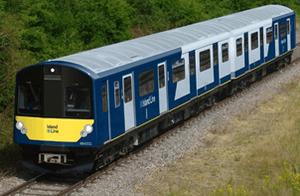British Rail Class 484
The British Rail Class 484 is a class of electric multiple unit which is to be built by rolling stock manufacturer Vivarail for the Island Line on the Isle of Wight. The units will be converted from London Underground D78 Stock, originally manufactured in the late 1970s and early 1980s by Metro-Cammell.
| British Rail Class 484 | |
|---|---|
 Artist's impression of Class 484 | |
| Manufacturer | Metro-Cammell Vivarail (conversion) |
| Family name | D-Train |
| Replaced | Class 483 |
| Constructed | 1978-1981 |
| Refurbished | 2020 |
| Number under construction | 5 |
| Formation | 2 cars per unit |
| Fleet numbers | 484001–484005 |
| Specifications | |
| Car length | 18.37 m (60 ft 3 in) (as D78) |
| Width | 2.85 m (9 ft 4 in) (as D78) |
| Height | 3.62 m (11 ft 11 in) (as D78) |
| Maximum speed | 60 mph (limited to 45 mph) |
| Electric system(s) | 750 V DC third rail [1] |
| Current collection method | Contact shoe |
| Multiple working | Within class |
| Track gauge | 1,435 mm (4 ft 8 1⁄2 in) standard gauge |
Five units are to be converted for Island Line to replace the Class 483 sets, with the first due to be delivered for testing in 2020.
History
The Island Line, an 8 1⁄2-mile (13.7 km) long rail route on the Isle of Wight between Ryde and Shanklin, has historically been limited in the type of rolling stock that can be operated due to clearance levels, particularly in the Ryde Tunnel between Ryde Esplanade and Ryde St John's Road. This continued even after electrification in 1966. Since 1989, rail services have been run using Class 483 units, which, prior to this, had been used on the London Underground's Northern line.[2] However, these units were first introduced on the Underground in 1938 and, by 2019, were more than eighty years old. This made them increasingly difficult to maintain, with the original fleet of eight eventually reduced to four in service, with another two retained as spares donors.[3][4] As a consequence, replacement of the rolling stock became an urgent priority - this requirement was eventually linked with a wider need to invest in improvements in the line itself, and saw suggestions that it might be converted to a light rail operation, or even a bus rapid transit route.[5] However, in 2019, it was announced that the existing third rail operation would be retained, with a total of £26m invested to make improvements. A significant proportion of this would be used on the procurement of a fleet of new trains, which it was announced would be sourced from Vivarail's D-Train platform.[6][7][8]
Trains
The Class 484 units will be two-car trains built using the existing bodyshells and bogies of former London Underground D78 stock units modified for use on the National Rail network. These will have similar features to the Class 230 trains from the same family, with wi-fi, power sockets and CCTV. The D78 Stock is similar in terms of height to other National Rail rolling stock in Great Britain, but having undertaken a survey of the route, Vivarail confirmed that its proposed units were capable of traversing the Ryde Tunnel.[9] Gauging trials had previously taken place in the 1960s to determine whether Class 503 units were suitable for use on the route.[10][11] The first of the total of five units was due to be delivered for testing in the summer of 2020,[12] but due to the COVID-19 pandemic, the first unit is now due to be delivered for testing in September 2020.[13]
Fleet details
| Class | Operator | No. built | Year built | Cars per set | Unit nos. |
|---|---|---|---|---|---|
| Class 484 | Island Line | 5 | 1978−1981 (built) | 2 | 484001 − 484005 |
| 2019−2020 (converted) | |||||
See also
Notes
- David Burroughs (16 September 2019). "Fleet and track upgrades in £26m Isle of Wight investment". International Railway Journal. Retrieved 7 January 2020.
- Hardy 2003, p. 60.
- Marsh, Phil (February 2019). Milner, Chris (ed.). "DfT decision on Island Line future deferred for three months". Headline News. The Railway Magazine. Vol. 165 no. 1415. Horncastle: Mortons Media Group (published 6 February 2019). p. 6. ISSN 0033-8923.
- Anon (26 March 2018). "Third Ryde Tube: Transfer Troublesome". London Reconnections. London Reconnections. Retrieved 27 March 2018.
- "IS THE FUTURE TRAMS AND STEAM TRAINS INTO RYDE?". islandecho.co.uk. Island Echo. Retrieved 18 February 2016.
- Isle of Wight line’s future secured with £26m investment Railway Gazette International 16 September 2019
- "£26m investment announced for Isle of Wight rail line". BBC News. BBC News. Retrieved 16 September 2019.
- "UK's oldest train fleet updated with £26m investment into Isle of Wight's railway". South Western Railway. South Western Railway. Retrieved 16 September 2019.
- "Vivarail to supply new train fleet for the Island Line". Rail Insider. 17 September 2019. Retrieved 5 June 2020.
- Dunn, Tim [@MrTimDunn] (23 April 2019). "Some people have asked "will the @Vivarail #class230 fit on the Isle of Wight to replace the 1938 Stock?"" (Tweet). Retrieved 17 September 2019 – via Twitter.
- "Ryde Rail - a history of tube trains on the Isle of Wight". Railway Modeller. Vol. 70 no. 827. September 2019. p. 779.
- Honey, Jade. "UK's oldest train fleet updated with £26m investment into Isle of Wight's railway". Isle of Wight Observer. Isle of Wight Observer. Retrieved 16 September 2019.
- Honey, Sally (1 June 2020). "New Island Line trains will be delayed". On The Wight. On The Wight. Retrieved 15 June 2020.
References
- Hardy, Brian (2003). Tube Trains on the Isle of Wight. Harrow Weald, Middlesex: Capital Transport. ISBN 978-1-85414-276-4.CS1 maint: ref=harv (link)
External links
![]()